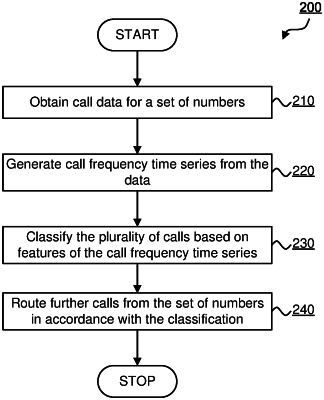| CPC H04M 7/00 (2013.01) [H04M 3/533 (2013.01); H04M 2203/15 (2013.01)] | 17 Claims |

|
1. A method of routing calls in a communications network, the method comprising:
obtaining data representing a plurality of calls previously made from a set of one or more numbers;
generating a call frequency time series for the set of numbers from the data by determining a respective number of calls made from the set of numbers during each of a plurality of time intervals;
classifying the plurality of calls based, at least in part, on one or more features of the call frequency time series, wherein the one or more features are derived from one or more characteristic variations in call frequency over time and the classification indicates whether the plurality of calls from the set of numbers includes automated calls; and
routing further calls from the set of numbers in accordance with the classification of the plurality of calls,
wherein the one or more features comprise one, or both, of:
transitions from quiet periods to busy periods; and
transitions from busy periods to quiet periods,
wherein the average number of calls during time intervals within a quiet period is lower than an average number of calls during time intervals within a busy period, and wherein the classification is based, at least in part, on the durations of the transitions.
|